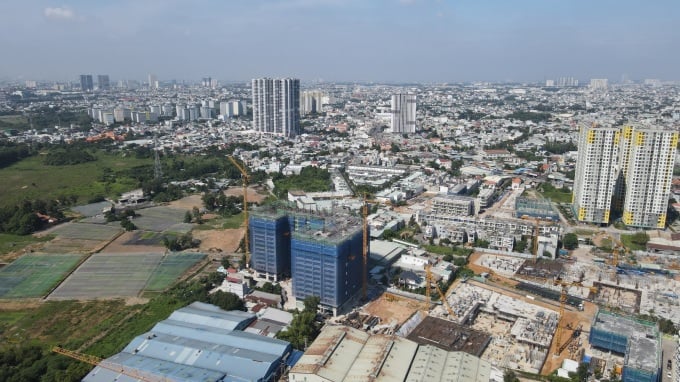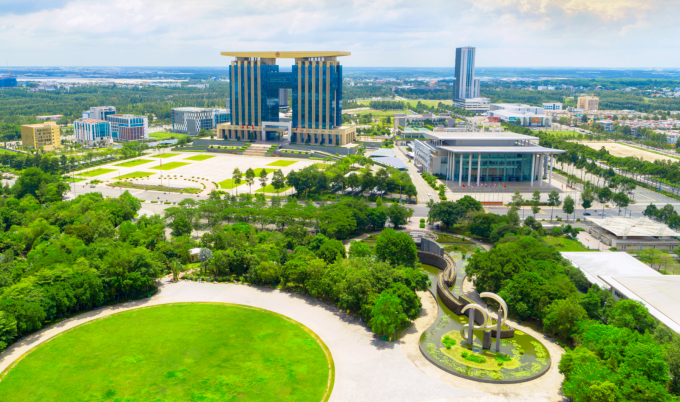Binh Duong province has just issued a socio-economic development plan, focusing on achieving the criteria of a centrally-run type I urban area.
Accordingly, the locality aims to become a modern, livable, civilized and humane city by 2030. The economic growth rate from 2021-2030 is on average 9-10%. The intra-regional and inter-regional transport system is being completed to become a trading hub. The province expects to increase the proportion of the service industry to 30% of GRDP, especially high-quality service industries towards becoming financial, commercial, educational and healthcare centers in the region. The average GRDP per capita is from 393-419 million VND. The urbanization rate is over 90%.

A corner of Di An urban area adjacent to the University Village urban area. Photo: Phuoc Tuan
Regarding industry, Binh Duong will form specialized industrial parks, green, circular 4.0 science and technology industrial parks, forming an industrial belt. The province also sets a target for the development of culture, society,education - training, and health sectors to be among the top localities in the country. The proportion of the digital economy in 2030 will reach 30-35% of the total GRDP. The number of unemployed people will be below 3%.
To achieve these indicators, Binh Duong has proposed many groups of solutions and tasks. In particular, the industrial capital plans to synchronize transport infrastructure connecting with Tan Son Nhat and Long Thanh airports, Cai Mep - Thi Vai port, and build Song Than station into a cargo transit center for the Southeast region. The province also studies and plans about 10,000 hectares of green industrial parks, applying high technology and neutralizing carbon. Industrial, urban, service and logistics belts are built around Ho Chi Minh City Ring Roads 3 and 4 and highways passing through the area.
The agricultural sector accounts for a low proportion in the economic structure, and is encouraged to transform towards ecology, apply technology for sustainable development, protect the environment, and create a closed chain from farming to consumption. In the education sector, the province encourages higher education institutions to establish science and technology enterprises, cooperate with many parties to transfer research achievements, etc.

A corner of Binh Duong Provincial Administrative Center. Photo: Provincial Information Portal
Cities such as Thu Dau Mot, Di An, Thuan An, Tan Uyen are the urban centers. Binh Duong allocates land for supermarkets and office buildings to form a financial center in this area. The suburban area is oriented to develop tourism along the Saigon River and Dong Nai River, forming an urban area along the river, connecting Tay Ninh - Binh Duong - Ho Chi Minh City.
Bau Bang, Dau Tieng, and Phu Giao districts will develop high-quality entertainment, recreation, medical treatment, and logistics to expand industry and connect with neighboring areas such as Tay Ninh and Binh Phuoc.
Binh Duong is the industrial capital of the Southeast region, with rapid growth over the past years. According to the results announced by the General Statistics Office, Binh Duong is the locality with the highest per capita income in the country in 2022, reaching 8,076 million VND/person/month. The province currently has 4 cities: Thu Dau Mot, Di An, Thuan An, Tan Uyen. Ben Cat town is expected to be recognized as a provincial city in the near future.
In the first 10 months of the year, Binh Duong's industrial production index increased by 4.2% over the same period, the value of trade and services reached 251,254 billion VND, up 13.1%, and export turnover reached 25.29 billion USD. During the same period, the province attracted 71,443 billion VND of domestic investment capital and 1.3 billion USD of FDI capital.
Hoai Phuong
Source link










![[Video] More than 100 universities announce tuition fees for the 2025–2026 academic year](https://vphoto.vietnam.vn/thumb/1200x675/vietnam/resource/IMAGE/2025/7/18/7eacdc721552429494cf919b3a65b42e)



















































































![[Infographic] In 2025, 47 products will achieve national OCOP](https://vphoto.vietnam.vn/thumb/402x226/vietnam/resource/IMAGE/2025/7/16/5d672398b0744db3ab920e05db8e5b7d)





Comment (0)